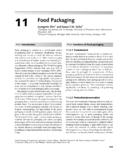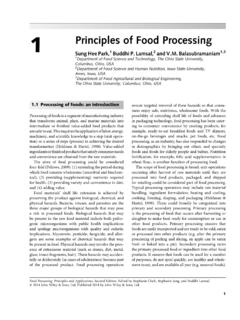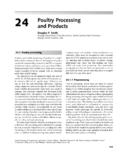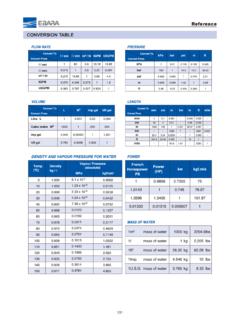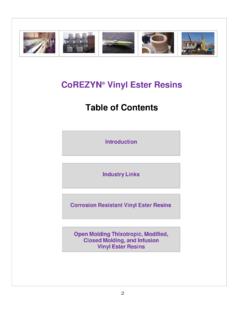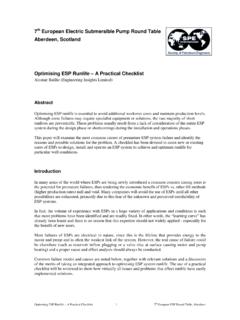Transcription of Sweeteners from 21 Starch: Production, Properties …
1 Sweeteners from 21. starch : production , Properties and uses Larry Hobbs I. Introduction .. 797. 1. History .. 797. 2. Definitions .. 799. 3. Regulatory Status .. 800. II. production Methods.. 800. 1. Maltodextrins .. 800. 2. Glucose/corn Syrups .. 802. 3. High-fructose Syrups.. 808. 4. Crystalline Fructose.. 813. 5. Crystalline Dextrose and Dextrose Syrups .. 813. 6. Oligosaccharide Syrups.. 816. III. Composition and Properties of Sweeteners from starch .. 817. 1. Carbohydrate Profiles .. 817. 2. Solids .. 818. 3. Viscosity .. 819. 4. Browning Reaction and Color.. 821. 5. Fermentability .. 822. 6. Foam Stabilization and Gel Strength .. 823. 7. Freezing Point Depression .. 824. 8. Boiling Point Elevation .. 824. 9. Gelatinization Temperature .. 824. 10.
2 Humectancy and Hygroscopicity .. 825. 11. Crystallization.. 826. 12. Sweetness .. 827. 13. Selection of Sweeteners .. 828. IV. References.. 829. I. Introduction 1. History Commercial production of sugar in the Indus valley was reported during Alexander the Great's invasion in the period around 325 BCE, but cane sugar did not reach Europe starch : Chemistry and Technology, Third Edition Copyright 2009, Elsevier Inc. ISBN: 978-0-12-746275-2 All rights reserved 798 Sweeteners from starch : production , Properties and uses until the Received at first as a novelty, Europeans developed a taste for sugar and demand for this new ingredient developed rapidly. During the sixteenth cen- tury, the Caribbean islands became major producers of this crop until the supply was disrupted during the Napoleonic Wars.
3 With cane sugar supplies cut off by the British blockade, France turned to sugar beets. In 1811, Kirchoff, a Russian chem- ist, discovered that acid-catalyzed hydrolysis of starch produced a sweet By 1831, an American syrup plant capable of producing 30 gallons (115 liters). of syrup per day utilizing this new technology had been built; 150 years later, 140. American plants were producing starch from corn, wheat, potatoes and Figure provides a dramatic presentation of the growth of the industry since The use of corn by the United States' corn refining industry increased to billion bushels (39 106 tons, 36 109 kg) in 1999, which was about 15% of the total crop harvested. From that production came 33 billion pounds (15 109 kg) of Sweeteners , more than times the amount produced in 1984 when the last edition of this book was 20.
4 19. 18. 17. 16. 15. 14. 13. Billions of pounds dry basis 12. 11. 10. 9. 8. 7. 6. 5. 4. 3. 2. 1. 1910 20 30 40 50 60 70 80 1990. Year Figure Corn sweetener shipments since I. Introduction 799. In order to discuss the changes that have happened in the industry and the forces driving them, it is necessary to first define the types of Sweeteners covered. 2. Definitions Dextrose equivalence (DE) is a measure of the total reducing sugars calculated as D-glucose on a dry weight basis. The approved method for determining DE is the Lane Eynon titration, which measures reduction of a copper sulfate solution. Unhydrolyzed starch has a DE value of zero, while the DE value of anhydrous D-glucose is 100. Glucose/corn syrups range from 20 to 95 DE. Maltodextrins are the dried products or purified aqueous solutions of saccharides obtained from edible starch having a dextrose equivalency of less than 20.
5 Outside the US, the products may be known as dextrins; only the US has an official definition of maltodextrins. Glucose syrups, also know as corn syrups in the US, are purified aqueous solutions of nutritive saccharides obtained from edible starch having a dextrose equivalency of 20 or more. Dried corn syrups or corn syrup solids are glucose/corn syrups from which most of the water has been removed. High fructose syrups are purified aqueous solutions of nutritive saccharides obtained from edible starch in which a portion (at least 42%) of the dextrose (D-glucose) has been isomerized to fructose. Crystalline fructose is crystalline product containing not less than fructose and not more than glucose. Dextrose monohydrate is purified, crystalline D-glucose containing one molecule of water of crystallization per molecule of D-glucose.
6 Anhydrous dextrose is purified, crystalline D-glucose without water of crystallization. Baume (Be) units arise from an arbitrary system of graduating hydrometers in degrees for determining the specific gravity of a solution. Within the corn refining industry, Baume is related to specific gravity by the following equation:6. 145. Baume (60 F/ 60 F) 145 (60 F/ 60 F). true The modulus of 145 is the ratio of the total volume displaced in water by the hydrometer and the volume displaced by the unit scale length of the hydrometer stem. Corn syrups are commercially available with Baume values of 42, 43 and 44. Degree of polymerization (DP) is the number of glucosyl (saccharide) units in an oligo- or polysaccharide. DP1 refers to a monosaccharide, DP2 refers to disaccharides and so on.
7 Refractive index (RI) is a measure of the refraction of light rays as they pass obliquely from one solution to another of different density. Refractive index is com- monly used to measure the solids level of Sweeteners . The refractive index of a sweet- ener is a function of the carbohydrate profiles, ash level, solids level and temperature of the solution. 800 Sweeteners from starch : production , Properties and uses Retrogradation is the reassociation of solubilized starch polymers in their native state or those in dextrins or in low-DE hydrolyzates resulting in an insoluble pre- cipitate. Dextrins are depolymerized starches produced by heating a starch moistened with dilute hydrochloric acid or heating a moist starch in the presence of gaseous hydrogen chloride until a cold-water-soluble product is formed.
8 Reversion is the condensation reaction of reducing sugars to form di- and higher oligosaccharides. 3. Regulatory Status Corn syrups, maltodextrins and D-glucose are affirmed as generally recognized as safe'. (GRAS) in the US Code of Federal Regulations (CFR) 21, Section 184. High fructose corn syrup was affirmed as GRAS in 21 CFR, Section on August 23, 1996. II. production Methods The pathways for production of the various Sweeteners share many common steps. A generalized sweetener process is shown in Figure production of each of the Sweeteners discussed will utilize one or more steps in this process. 1. Maltodextrins The GRAS affirmation contained in 21 CFR, Section , defines maltodex- trins as non-sweet, nutritive saccharide polymers consisting of D-glucosyl units linked primarily with alpha-1,4 bonds and having a DE less than 20.
9 The document has been modified to include maltodextrins derived from potato starch as In 1992, more than 328 million pounds (149 106 kg) of maltodextrins and corn syrup solids were produced in the United States from various starch Maltodextrins may be manufactured either by acid or by acid enzyme processes. Maltodextrins produced by acid conversion of starch from dent corn contain a high percentage of linear fragments, which may slowly reassociate into insoluble com- pounds causing haze in certain applications. Haze formation, which results from retrogradation, can be overcome by use of alpha-amylases. Alpha-amylases preferentially cleave the alpha-l,4-D-glucosidic bonds of amylose and amylopectin (see Chapter 7), leaving a higher proportion of branched fragments, decreasing the ability of the fragments to reassociate.
10 Maltodextrins made from waxy corn starch also have a lower tendency to haze, because such starch is composed almost entirely of the highly branched molecule, amylopectin. In a maltodextrin process using enzyme-catalyzed conversion, the starch slurry (30% to 40% dry solids) is first pasted at a temperature of 80 90 C, and is then treated with a heat-stable' bacterial alpha-amylase for liquefication. When stabilized with calcium ions, alpha-amylases from B. licheniformis or B. stearothermophilus can withstand temperatures of 90 105 C for at least 30 minutes,10 allowing sufficient process time to split the 1,4 bonds and form maltose and limit dextrins (see Chapter 7). II. production Methods 801. starch Low-conversion products High-conversion products Acid/enzyme Liquefaction hydrolysis Saccharification Refining Refining Evaporation High-conversion hydrolyzate Drum or spray drying Evaporation Corn syrup Maltodextrin, corn syrup solids Isomerization Crystallization (Glucose-rich fraction).
